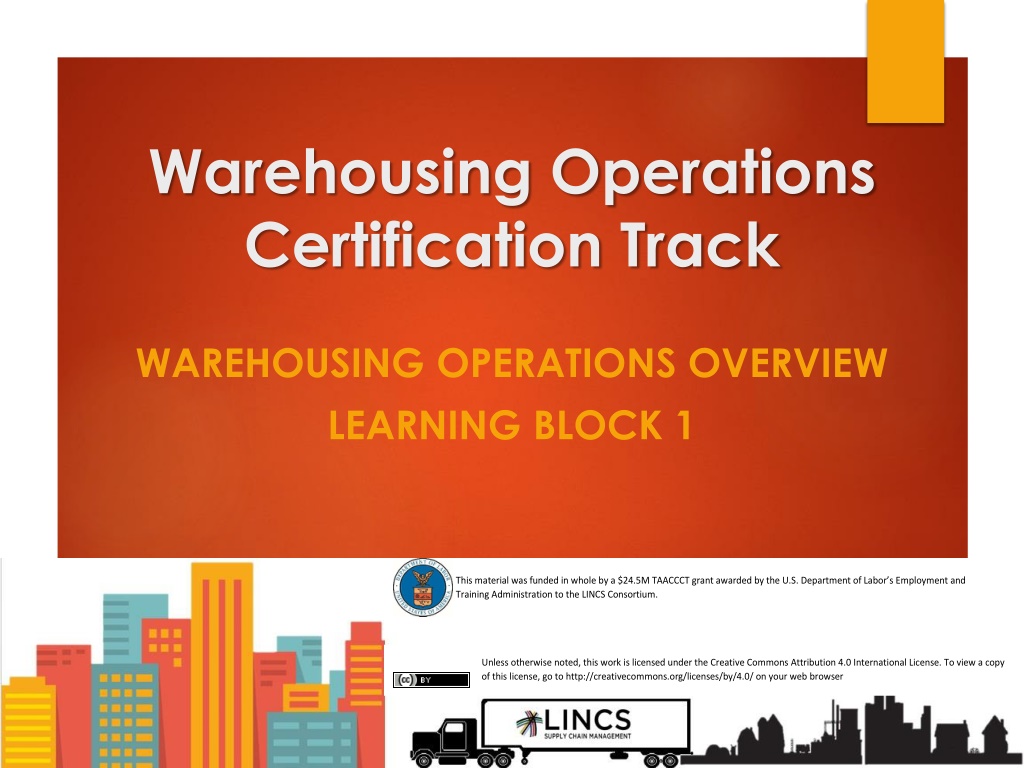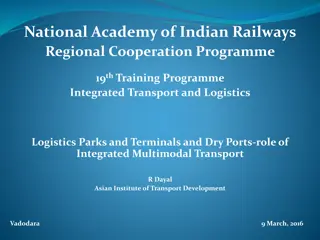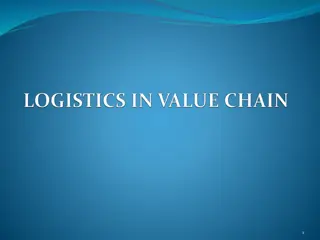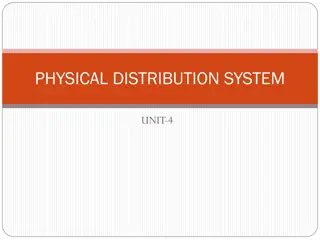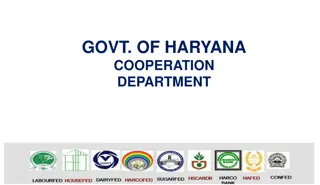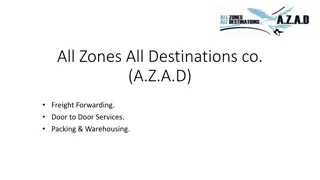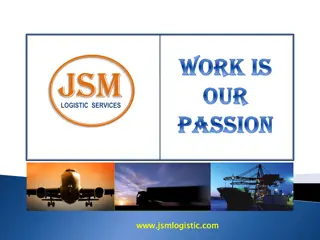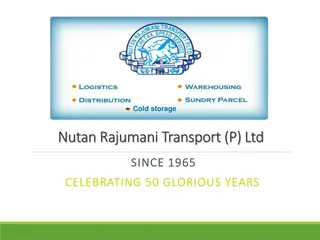Evolution of Warehousing Operations Through History
Warehousing operations have evolved over centuries to become essential components of efficient supply chains. Initially used for storing food, warehouses now play crucial roles in processing, storing, and distributing goods across various industries. The history of warehouses reflects the advancements in transportation, industrialization, and the increasing complexity of supply chains, emphasizing the importance of effective warehouse management in today's global market.
Download Presentation

Please find below an Image/Link to download the presentation.
The content on the website is provided AS IS for your information and personal use only. It may not be sold, licensed, or shared on other websites without obtaining consent from the author. Download presentation by click this link. If you encounter any issues during the download, it is possible that the publisher has removed the file from their server.
E N D
Presentation Transcript
Warehousing Operations Certification Track WAREHOUSING OPERATIONS OVERVIEW LEARNING BLOCK 1 SCPro Fundamentals Training Program SCPro Fundamentals Training Program This material was funded in whole by a $24.5M TAACCCT grant awarded by the U.S. Department of Labor s Employment and Training Administration to the LINCS Consortium. Unless otherwise noted, this work is licensed under the Creative Commons Attribution 4.0 International License. To view a copy of this license, go to http://creativecommons.org/licenses/by/4.0/ on your web browser
Warehouse Operations Overview/Description Warehousing Operations encompass the processes, procedures, tools, and equipment within a warehouse facility as enablers for an efficient, effective, and comprehensive supply chain. Warehouses do not operate as stand-alone facilities but require strong collaboration and communication with other Inventory Management, Transportation Operations, Demand Planning, Procurement, Manufacturing, and Customer Service functions. Each warehouse or distribution center is a facility used to store goods and is a critical element in the overall supply chain. The primary purpose of the warehousing facility is to receive, store, and process goods for the eventual shipment and distribution to manufacturing operations, other businesses, and consumers. Warehousing operations also include internal processes and technology which link to the broader supply chain. These operations help to coordinate the incoming goods, store and track the goods, and ultimately ship and distribute goods to their intended destinations.
Warehousing Operations Learning Objectives Describe why warehouses were established and why they evolved Understand/distinguish the differences between a physical warehouse and warehouse operations Describe differing types of warehouse operations and the basic characteristics of each Explain/understand many of the enablers necessary to run a warehouse
Warehousing - History The warehousing industry has been around for hundreds of years. The genesis for warehouses goes back to the need to store food, but they evolved as European explorers created shipping and trade routes with other nations. Warehouses grew in importance for the storage of products and commodities, and they became terminal points for land, sea, and eventually air routes. As transportation became more sophisticated and diverse, warehouse operations have broadened and become more diverse and complex as well. Around the mid-20th century, warehousing underwent another transformation, due to the rise of industrial factories and mass production. The increased volume of products resulted in a need for additional storage facilities and more efficient and effective means of storing, controlling, and retrieving raw materials and finished products
Warehousing - History Most of the early warehouses were built at sea ports for temporary storage of inbound and outbound shipments. As railroads were built to achieve greater amounts of cross-country travel, warehouses were established along the rail routes. These depots were built in areas and locations that were more convenient and closer to the intended use of the products being stored. Around the mid-20th century, warehousing underwent another transformation, due to the rise of industrial factories and mass production. The increased volume of products resulted in a need for additional storage facilities and more efficient and effective means of storing, controlling, and retrieving raw materials and finished products. Efficient air transport enabled the timely shipments of goods over longer domestic and international routes, and the demand for warehousing increased at airports.
Warehousing - Today Picture a warehouse as a building, or simply a physical asset, used to receive, store, and ship goods. Many warehouses today operate simply for this purpose. While many companies continue to use warehouses solely for bulk storage, a great number of companies are now striving to utilize their warehouses as more than simply storage facilities. Companies are transforming themselves into third party logistics providers (3PLs) who provide a wide array of services and functions. 3PLs can best be described as firms who provide services to customers for outsourced, or third party, logistics services for part, or the entirety of their supply chain management functions. In addition to packing and staging goods on racks and pallets, warehousing facilities offer value-added manufacturing, call centers, labeling, and other value-added functionality. Warehousing operational processes that integrate basic and value added functions enable a warehouse building to operate as a distribution or fulfillment center. These processes enable the operation of distribution centers (Walmart), fulfillment centers (Amazon), value-added manufacturing centers (Dell Computer), and warehouse- style retail stores (Home Depot).
Warehousing Today Warehouse-style retail stores have large amounts of products stored on industrial racks, rather than only on conventional retail-type shelving. Customers are able to buy products in bulk, and ready to be sold stock is generally placed on bottom racks. Meanwhile, crated inventory, or inventory placed on pallets, is stored higher up and is lowered when it becomes necessary. In this way, these buildings function as both warehouses and retail stores . Finally, technological innovation coupled with agile manufacturing processes, including just-in-time (JIT) manufacturing and innovations in transportation, are making warehousing sometimes unnecessary because products can be shipped directly from manufacturers to customers.
Warehouse Operations Delivery of goods and materials takes place either by truck, rail, or boat on a dock or loading area. The goods are received, processed, and then sent into the warehouse for storage. The storage of goods is the primary function for warehouses. Once the goods have been received from the manufacturer or shipper, they are compactly stored to maximize availability within the facility. Products are placed on pallets, or racks, which allow for more consistent stacking and moving within the facility. Warehouses can be designed to optimize the flow of goods in the supply chain, and there are numerous types of designs companies may use based on the overall strategic mission, goals, and desired customer base.
Warehouse Operations - 5 Popular Methods Public Warehousing - involves a company or multiple companies paying a standard fee for the storage and processing of goods. Private Warehousing - is defined as storage and operations controlled completely by a single company. Leased Warehousing - might be an option for more unstable inventory. Companies who manufacture products with seasonal demand often lease space to accommodate finished goods to prepare for the peak demand periods. Retail Warehousing - has recently grown in popularity. Retailers, such as Home Depot and Lowes, provide goods for consumers while maintaining an active warehouse to quickly replenish the consumption. Contract Warehousing - are dedicated facilities with procedures designed for the client s operations.
Warehouse Operations Key Enablers Receiving and shipping docks to accommodate vehicle unloading and loading. Staging area and supplies for packaging and packing of goods. Racks, pallets, conveyers, and other specialized capital equipment and storage systems to assure the safe and efficient handling and storage of goods. Dedicated areas where products from different suppliers are mixed and then distributed to fulfill and complete customer orders. Forklifts, overhead cranes, and other materials handling equipment to easily and safely move heavy goods and pallets within the warehouse and to unload and load transportation vehicles.
Warehouse Operations Key enablers Warehouse management systems (WMS) assist warehouse personnel in tracking products throughout the entire storage and distribution process. These systems span from simple computer automation systems to high-end, feature-rich software programs. These systems improve order picking, facilitate better dock logistics, and monitor inventory management. Radio Frequency Identification (RFID) systems are linked to the WMS to facilitate inventory tracking. Additionally, voice-activated receiving and packaging allows for warehouse personnel to speak requests into the WMS, thus speeding the entire process. Finally, transportation management systems also linked to WMS provide an advanced level of detail on goods prior to their arrival and they also provide a more specific time of delivery. Sales, operations, and customer service offices also offer support to the supply chain. Cold storage and temperature control capabilities for the preservation of agricultural products and other perishable goods.
Warehouse Operations Summary Warehouses are assets used for goods, receiving short and long term storage, control and shipment to satisfy customer, and consumer demands. The warehouse operational processes must be synchronized with demand planning, procurement, inventory management, manufacturing and service operations, and transportation operations. These supply chain elements, working in unison and defined by the broader supply chain mission drive the configuration, layout, location, technology innovations, and financial considerations to operate as a private, public, leased, retail, or contract facility.
Warehousing Operations Certification Track WAREHOUSING DESIGN AND FUNCTIONALITY LEARNING BLOCK 2
Warehousing - Design and Functionality The warehouse or distribution center is a place in which inventory is held for varying periods of time. In a best case scenario, the supply chain is constantly moving raw materials to be made into finished goods to send to the end customer. However, there are many reasons to interrupt the flow of goods in the supply chain, such as to support quality, value, costs, and efficiency. Warehouses can also be used to add value to products and add value for customers. For all these reasons both the design and functionality of warehouses today can be super- critical to the overall success of a supply chain...
Warehousing Design and Functionality Learning Objectives Understand and describe the various types of warehouses Be aware of various warehouse decision options Describe the major warehouse functions Define and understand value-added roles of warehouses
Warehousing Design and Functionality Basic Warehouse Decisions The warehousing strategy for any company needs to be planned and designed to define it s most effective role in the overall supply chain. Some primary decisions used to establish a sound, cohesive warehousing operational strategy: Type of warehouse (private, public, retail) Centralized versus decentralized locations Size, location, and material handling equipment Size, type, and quantity of packaging and packing materials Facility layout and flow of goods Types of goods to be processed Employee Safety
Types of Warehouses Today, companies use public, retail, or private warehouses to meet their storage and distribution needs. The first decision is based on a financial analysis of available alternatives to satisfy the needs of the overall supply chain in order to meet the strategic needs of the organization. In making this decision, organizations have several alternatives: private ownership, use of public warehouses, leased space, or retail warehouses. In addition to making this choice, many organizations might even combine the options in a hybrid fashion because of varying regional market conditions, customer volumes, customer requirements, and other factors (e.g., seasonality). Organizations typically approach the ownership decision in a tradeoff framework. Certain operations tend to lend themselves to private warehousing. Whereas other organizations lend themselves best to public or leased facilities, in which companies rent or lease space or contract basis according to need.
Warehouse Types - Public Public warehouses are operated by firms engaged in storing and processing goods for a fee, and normally, they do not own the goods. Several factors lend themselves to companies using public warehouses: Financial investment: The use of public warehousing enables an organization to preserve precious capital funds as they pay a fee for the desired services. This enables an organization to utilize capital funds for product development and innovation in order to stay competitive in the marketplace. Flexibility: Firms can rent space for shorter or longer periods of time as required, enabling the firm to react quickly to movements in demand or changes in the quality of transportation services. Exploring new markets also requires location flexibility; public warehouses enable firms to immediately launch in, expand in, or pull out of new, untried markets without lingering distribution costs. Public warehouses are run by third-party operators (or providers) who may provide a wider variety of services for manufacturers and suppliers who decide to outsource their warehouse operations, either in part or in whole. Third-party operators can provide a full range of distribution management services for customers and integrate these services within a total logistics system.
Warehouse Types Leased Leased Warehouses - Organizations generally opt to utilize leased warehouse space to maintain control of the goods and materials, but these same organizations may not have the financial capital resources to privately own the land and improvements. These decisions are derived based on the organizational financial analysis. In addition to making a lease versus buy (own) decision for the land and building, organizations must also determine the financial impact of providing their own labor and infrastructure requirements versus having them provided under a contract with a third- party provider.
Warehouse Types Retail Consumer demand for immediate availability of goods and materials has supported the growth of the retail warehouse option for many organizations. While the obvious retail warehouse operations are Home Depot and Lowes, there are also many other organizations that operate using this same concept, referred to as box retailers. Examples include Office Depot, DSW Shoes, Dick s Sporting Goods, Costco and BJ s (Costco and BJ s are club stores that require membership, but the availability of goods are still presented to consumers in a warehouse-type environment) where large amounts of inventory are kept on hand to support consumer demands and prevent loss of sales. Retail warehouses are also operated in a hybrid fashion and the retail outlet is supported by a network of private, public, or leased facilities that enable efficient replenishment based on sales and keeping goods and materials on the shelf, available for consumers.
Warehouse Locations Centralized vs. Decentralized Another important warehouse decision is whether organizations will use a centralized (single) location or decentralized (numerous) locations for the warehouse and distribution strategy. The market can be relatively simple, depending on the organization s size; for example, small- and medium-sized companies with a regional market area will often need only one or two warehouses. Larger firms with national or international markets need to develop a more comprehensive strategy. When making decisions about centralized or decentralized warehouses, firms use a tradeoff framework to analyze the need for warehouses in various areas. Supply and demand conditions will make one alternative more attractive than others. For example, a firm manufacturing or distributing a highly competitive product on a national basis may need to use a decentralized warehousing network to provide rapid service in its chosen market areas. Firms have to closely coordinate the decision about the number of warehouses with their decisions about transportation alternatives. For example, air freight has made rapid national market coverage from one or two strategically positioned warehouses possible.
Foreign Trade Zones FTZs are approved geographical areas which are considered to be outside of the United States, even though they are located on U.S. soil. FTZs are designated for duty and customs purposes. They can be a single building or a complete industrial park, and they do not have to be adjacent to an airport or seaport. Every U.S. state and Puerto Rico have at least one FTZ within their borders, and having warehouse operations within an FTZ can dramatically lower the cost of doing business. Many U.S. businesses have to import material from around the globe in the form of raw materials, parts, and components. If high tariffs are imposed on the imports, it drives-up the cost of their products and causes their business to become less competitive in the marketplace. U.S. businesses located in an approved FTZ do not pay import duty and other designated fees on products they import until those products are moved out of the FTZ and into the U.S. marketplace. On the other hand, if the finished products are moved out of the FTZ for export out of the U.S., no duty is owed.
Warehouse Physical Size and Location Important characteristics for consideration: Access to desired modes of transportation Proximity to markets and customers Supplier networks Land costs and utilities Availability of desired labor skills
Warehouse - Layout Important characteristics for optimizing a layout: Cubic utilization and capacity Product protection Level of mechanization Safety Product physical characteristics Productivity and performance Shifts and staffing levels
Warehouse Items Stocked Every unique item is commonly referred to as a SKU, defined as a stock keeping unit. Attributes associated with a specific item help distinguish it from other item types to make a particular item unique. These attributes could include, but are not limited to, manufacturer, description, material, size, color, packaging, and warranty terms. When a business takes an inventory, it counts the quantity it has of each SKU. SKU also refers to a unique identifier or code. The identifiers and codes are not regulated or standardized. When a company receives items from a supplier, it has a choice of maintaining the supplier s SKU or creating its own. Other warehousing decisions involve what items firms should stock and how much stock should be assigned to various warehouses. Firms with a number of locations must decide if certain locations will carry the whole product line, if each warehouse will have any specialization, or if warehouses will combine specialization and general stocking.
Warehouse Operations Employee Safety Employee level of risk is often based on the proper equipment and training for proper handling of materials and hazardous materials. Employee safety is a major issue and it influences layout of facilities and quantity and location of safety-related equipment (e.g., sprinklers, fire hoses, etc.).
Warehouse Operations Movement and Storage Functions Four distinct operations: Unloading and receiving goods into warehouses from the transport network Transferring goods to particular locations Selecting particular combinations of goods for customer orders or raw materials for manufacturing operations Staging, consolidating, and loading goods for subsequent manufacturing operations or shipping to a customer
Warehouse Operations - Movement Goods generally move through a warehouse rapidly, resulting in inventory turnover. Inventory turnover is usually expressed as ratio showing how many times a company's inventory is sold and replaced over a period, generally a year. The reason for quick movement is because of the high cost of holding finished goods for long periods of time. Finished goods have high value, need more sophisticated storage facilities, and have greater risks for damage, loss, and obsolescence, which contributes to higher inventory costs. Moving goods quickly and efficiently through warehouses is, therefore, important in order to optimize the supply chain.
Warehouse Operations - Storage Warehouses may store goods for longer periods of time for final processing. However, accurately forecasting inventory requirements may prove difficult for firms facing erratic demand for their goods. In these cases, firms may need to store relatively large inventories to preclude stock-outs (e.g., warehouses carrying fashion goods). Another common reason for storing finished goods is because firms are affected by seasonality of demand. For example, a firm that manufactures and distributes ski equipment may need to begin accumulating its inventory for the winter in July and August, which may have been manufactured in June. Other reasons for carrying stock for relatively lengthy periods of time include speculative, or forward buying of goods in anticipation of future price spikes or shortages (e.g., wheat held in anticipation of future shortages). Other reasons include special deals for businesses, in which goods are held after purchase to take advantage of lot quantity discounts offered by manufacturers.
Warehouse Operations Information Technology The amount and quantity of transactions that take place on a daily basis can be overwhelming if it is not properly managed. The WMS integrates computer hardware with specialized software and it enables personnel to receive, stock, pull, and ship orders. The WMS, linked to other supply chain elements like procurement and transportation, is the main operating system in most warehouses, distribution centers, and fulfillment centers today. The WMS enables personnel to track receipts, assign inventory locations, and plan replenishment orders and customer orders. Replenishment orders re-supply warehouses from manufacturers, and customer orders dictate when to move goods from distribution facilities to customer locations. In either case, order fulfillment requires a series of activities, such as order placement, order processing, order preparation, and order shipment, which require effective information management. Technologies used to facilitate information flow include barcodes, radio frequency identification (RFID) tags and systems, and electronic data interchange (EDI).
Warehouse Operations Information Technologies Barcodes are labels and they represent the most commonly used automatic-identification technology in distribution. A barcode is a series of parallel black and white bars of varying widths whose sequences represent letters or numbers. This sequence is a code that scanners can translate into important information to communicate with the WMS. RFID is a wireless use of electronic fields to transfer data for the purposes of automatically identifying and tracking tags that are attached to objects. Unlike a barcode, the tag does not necessarily need to be within line of sight of the reader and may be embedded in the tracked object. At warehouses, information received through the EDI network can be used to drive many distribution functions. The timely and accurate receipt and transmission of data allows for efficiently scheduling and handling inbound shipments, routing goods through warehouses, and measuring throughput levels (and costs) using automated systems.
Warehouse Operations The Order Management System The order management system represents the principal means by which buyers and sellers communicate information relating to customer orders for goods. The order management system is also one of the most important components of firms overall management information systems. The overall area of order placement, order processing, order preparation, and shipping has benefited from the enhanced computer information system technologies available today
Warehouse Operations Principal Information Flows Order Placement and Inquiry - Order placement time can vary from days (by mail) to minutes (by phone). Using the internet or EDI, order placement can take place instantaneously from customers directly to suppliers. Order processing - The order processing function involves checking customer credit, transferring information to sales records, sending the order to the inventory area, and preparing shipping documents.
Warehouse Operations Principal Information Flows Order Preparation Depending on the commodity to be handled and other factors, the order preparation process may be very simple and performed manually or may be complex and highly automated. Once the order is picked, it is packed and packaged to prepare for shipment. Order Shipment - Order shipment includes the time it takes from placing the order on a truck for movement to the time it is received and unloaded at the buyer s destination.
Warehouse Operations Value Added Opportunities Warehouses can be used to add value to enhance customer service. Warehouses are the point in the supply chain where stock is held for varying periods of time. A warehouse can also be used to add value to products while avoiding disruption and delays in traditional manufacturing. Warehouses also allow for delaying customization and finishing until a customer orders the product. This cuts down on inventory levels and lowers the cost of final products. Important value-added concepts: Transportation consolidation - Transportation consolidation involves combining smaller shipments to form a larger quantity to realize lower transportation rates. Product Mixing - Companies often produce items at different physical locations, so companies without warehouses would have to fill orders from several different locations, causing several different arrival times and opportunities for errors to occur. Therefore, product mixing functions at warehouses for multiple product lines lead to efficient order filling and reduced transportation costs through consolidating mixed loads. Break Bulk - In break bulk, large shipments of manufacturers products are broken down into smaller units, which are shipped to multiple customers.
Warehouse Operations Value Added Opportunities More value-added opportunities: Cross-docking - As an alternative to placing items into storage, cross-docking is used on the highest velocity and demand items. When products are received, this process enables immediate sorting and shipping without ever being placed in storage. In cross-docking operations, the storage, or holding, function is temporary and short term. Customer Service - Customer service provides a competitive advantage to companies. Having goods available in warehouses when customers place orders (particularly if warehouses are reasonably close to customers, including retail warehouses) will usually lead to customer satisfaction, enhance future sales, and contribute to customer retention. Protection - Protection against contingencies, such as transportation delays, supplier stock- outs, strikes, or inclement weather is important for physical supply warehouses because delays in the delivery of raw materials can delay manufacturing operations.
Warehouse Operations Value Added Opportunities More value-added opportunities: Smoothing - Smoothing out production and distribution operations is a sixth warehouse function. Consider a snowboard manufacturer as an example of an organization that employs a smoothing technique. The demand is seasonal, but materials are fed from the warehouse to the manufacturing line at a constant rate to achieve a smooth level rate of production. Staging - Oftentimes, a wide variety of products, materials, and equipment are required to be gathered over a period of time to meet customers requirements; this is sometimes referred to as project logistics. Kitting - Kitting is a value-added process performed in warehouses where individually separate, but related, items are grouped and packaged together to create a special single product.
Warehousing Design and Functionality Learning Summary There are various forms of warehousing and associated operational processes that enable organizations numerous options to optimize the supply chain. The value-add activities (e.g., product mixing, staging, etc.) are defined by the broader goals for an organization and its supply chain. In developing distribution strategies, companies must address questions regarding the merits of private, public, and leased warehouses and centralized versus decentralized networks, location, number, layout, and size, including proximity to transportation options. Warehouses generally consist of movement, storage, and administrative functions supported by information systems to facilitate flow inside the facility and with customers and suppliers. Information technology, such as barcode scanners, are important in order to ensure effective and error-free operations.
Warehousing Operations Certification Track THE RECEIVING FUNCTION LEARNING BLOCK 3
The Receiving of Goods and Materials - Objective The objective of the receiving function is to assure that goods and materials delivered to warehouses are verified against ordering documentation and checked for shipping damage. In the receiving area, incoming goods and materials are normally unpacked, checked for quantity accuracy and product damage, repackaged, organized into a storable format (where required), entered into the inventory system, have markings/labels applied, and staged for movement to a storage area. Cross-docking and certain value-added activities could also take place here.
The Receiving Function Learning Objectives Name the main objectives of the receiving function in warehouses Describe the detailed steps of receiving goods and materials Explain three major types of receiving dock locations List key performance metric examples and describe best practices in receiving goods into warehouses
The Receiving Function Goods Receipt and Receiving Activities Goods Receipt - The receiving area needs to be designed to assure the space, tools, and equipment are allocated to accommodate and process the intended receipts. Typical receiving activities: Scheduling delivery vehicles and yard control Unloading product from the delivery vehicles Checking product quality and quantity Entering data into the warehouse management inventory system Safeguarding and labeling Completing JIT and cross-dock activity
The Receiving Function Scheduling Delivery Vehicles and Yard Control Yard control activities include scheduling inbound vehicles for offloading, restraining vehicles, checking seals, opening of the truck door, and inspecting the trailer or load condition. Other yard control activities include: Using chocks behind the trailer driver side rear wheels or other means of vehicle restraint Checking the seal and opening the truck door Inspecting the trailer or load condition for damage or contaminants
The Receiving Function Dock Types Combined With a combination docks arrangement receiving and shipping activities are performed in one common area, so fewer dock positions are needed. Scattered A scattered dock arrangement has incoming goods delivered to a number of points on the perimeter of a warehouse close to the point of use. Separated - In the separated dock arrangement, incoming goods are delivered to a number of points on the perimeter along one exterior wall.
The Receiving Function Checking Product Quality and Verifying Quantities The third main receiving activity is to verify that incoming goods and materials are not damaged or contaminated and that the quantity is verified against what was ordered. This activity ensures that the product delivered to warehouses is what was ordered, the quality is acceptable, and the quantity is correct. Once a receipt has been verified for quality and quantity, it is entered into a WMS. At this point, any discrepancies are documented using the designated process. Any missing or damaged cartons in transit may become the responsibility of the freight carrier or transport company. Suppliers and manufacturers would be notified if the order is damaged, contaminated, has incorrect quantities, or has missing or wrong products. Organizations can also use a total quality program with their suppliers. This type of program aims for quality at the source, or doing it right the first time at the supplier s site. This reduces or eliminates the need for performing quality checks on receipts. In cases when the product is incorrect or damaged, it will normally be held in a separated, clearly demarcated holding area for disposition.
The Receiving Function Entering Data into the Warehouse Management System The next receiving activity is to update the inventory system. Receiving department employees enter the SKU quantities into the system and transfer the goods from the receiving department staging area to the designated storage or staging area. In warehouses that use barcode scanners or other means of capturing receipt information, employees ensure that data is automatically entered during the scanning process. However, in warehouses that use paper-based transactions (e.g., receiving documents), employees may need a more extensive key entry to input product and quantity data.
The Receiving Function Safeguarding and Labeling In certain retail warehouse operations, a sub-activity of product receiving is the SKU labeling activities, in which a unique label is placed onto each SKU. In this activity, the procedure includes a mechanical printer that prints labels, which are then glued, clipped to, stitched into, or hooked onto the SKU. Repackaging and other safeguarding operations may take place prior to further processing and storage. The purpose of this activity is to convert the product from a bulk form (e.g., products tossed into a large bin without individual packaging or wrapping) to a form that is ready to be placed into storage. These activities can also involve unit load transformation.
The Receiving Function Important Container Types Intermodal Containers Large, standardized, rugged, steel containers able to be used on ships, trucks and railways. Wood Pallets The most commonly used means of freight transportation and moved by tow motors, forklifts etc. Re-usable Plastic Containers Are generally sturdy, one size and used to move items within a warehouse or manufacturing facility.
The Receiving Function A modern Computerized example A worker meets the truck at the receiving dock to receive and check-in incoming goods. The worker uses a Radio Frequency Terminal (RFT) which has a keyboard, a small printer, and an attached barcode scanner; it also receives information from, and sends information to, the WMS. RFTs can be hand held or mounted on a cart for mobility. If there are computer or communications issues, a computerized warehouse may resort to paper-based tracking of receipts as a back-up until the computer is online. In fact, many smaller warehouse operations still work on a paper-based system, in which warehouse activities are noted on paper (rather than captured on an RFT), and receipts are manually typed into a computer by a receiving, shipping, or inventory clerk. RFTs may scan barcodes or other identifiers and transmit the data to the computer system to reconcile received goods with purchase orders. Specific products and quantities are identified, and any damage or suspected damage is recorded. Trailers are then unloaded according to RFT instructions. RFTs can also generate carrier receipts, RFTs provide detailed instructions to operators. These onscreen instructions specify the sequence of activities that should take place. Shipments are received in various types of containers, but the shipment container markings of one kind or another are generally attached to goods that have been unitized. A unitized load is a consolidation of a number of items into one shipping unit to make handling easier. Loads can be unitized by banding, binding, or wrapping. The shipment container marking may even be attached to a trailer that has been sealed and secured prior to shipment. Goods are commonly unitized on pallets, which are typically wooden platforms used for stacking and transporting products as a unit load. They are commonly four foot squares and constructed to place forklifts forks between the platform levels. RFTs can also print barcode labels, which are used to direct and track the movement of goods. Information required for barcode labels are sent from the WMS to the RFT, which prints a barcode label. This label is attached to the goods in the receiving area.
The Receiving Function Key Metrics used in Receiving Relevant KPIs for the receiving function may include: Cost: Cost of receiving per receiving line Productivity: Volume received per labor hour measured in terms of pallets, cases, etc. Utilization: Receiving dock door utilization percentage Quality: Accurate receipts percentage Cycle Time: Time taken to process a receipt
